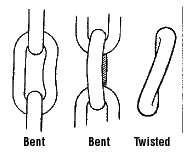Materials Handling - Chain Slings
On this page
What should you know about using synthetic web slings?
Chain slings are suited to lifting loads that require flexibility and resistance to abrasion, cutting, and high temperatures.
Who should inspect chain slings?
Back to topAll sling inspections should be performed by qualified individuals with appropriate knowledge, training, and experience. These individuals can be referred to as competent persons.
When should you inspect chain slings?
Back to topAll slings (new, altered, modified, or repaired) should be inspected by a competent person before they are used in the workplace to make sure they are built to specifications, not damaged, and is appropriate for the work being performed. For record-keeping purposes, it is useful if each chain has a metal tag with an identification number and load limit information. Information about the chain length, other characteristics, and an inspection schedule should be recorded in a logbook.
A competent person must also inspect chain slings periodically, and at least once a year. Inspection frequency is based on how often the sling is used, the types of lifts being performed, the conditions in which the sling is being used, and past experience with the service life of similar slings and usage. If the sling is used in more severe conditions, then the inspection should be performed more frequently. Inspections must be recorded.
In addition to the inspections by a competent person, the user should inspect chain slings and accessories before each use and before placing them into storage. Check for visible faults in links and hooks and distortion of fittings.
How should chain slings be checked during inspection?
Back to top- Clean the sling before inspection.
- Check identification tag
- Hang the chain up or stretch the chain out on a level floor in a well-lighted area. Remove all twists. Measure the sling length. Discard if a sling has been stretched.
- Make a link-by-link inspection and discard if:
a) Inner link wear exceeds the manufacturer's guidance for allowable wear. Manufacturers often publish tables and supply wear gauges indicating the amount of allowable wear for each link size.

b) Cut, nicked, cracked, gouged, burned, weld splattered, or corrosion pitted.

c) Deformed, twisted or bent chain links or components.

d) Stretched or not moving freely. Links tend to close up and get longer.

- Check the master link, load pins, and hooks for any of the above faults. Hooks should be removed from service if they have been opened more than 15% of the normal throat opening, measured at the narrowest point, or twisted more than 10° from the plane of the unbent hook.
- Refer to manufacturers' reference charts showing sling and hitch capacities. Record manufacturer, type, load limit and inspection dates.
How should you use chain slings safely?
Back to top- Always know how to properly use the equipment and understand the slinging procedures before attempting the lift operation.
- Inspect the slings and accessories before use for any defects.
- Replace broken safety latches.
- Find out the load weight before lifting. Do not exceed the rated load of the sling.
- Check whether chain slings fit freely. Do not force, hammer or wedge chain slings or fittings into position.
- Keep hands and fingers away from between the load and chain when tensioning slings and when landing loads.
- Ensure the load can be lifted freely.
- Make a trial lift and trial lower to ensure the load is balanced, stable, and secure.
- Balance the load to not overstress on one sling arm or to prevent the load from slipping free.
- Lower the working load limit if a severe impact may occur.
- Pad sharp corners and edges to prevent bending links and to protect the load.
- Position hooks of multi-leg slings facing outward from the load.
- Cordon off the area.
- Reduce the load limit when using chains in temperatures above 425°C (800°F).
- Store chain sling arms on racks in assigned areas and not lying on the ground. The storage area should be dry, clean and free of any contaminants which may harm the sling.
- Use grab hooks or shortening clutches if the sling needs to be shortened.
What should you avoid when using chain slings?
Back to top- Do not jerk the load when lifting or lowering the sling. This motion increases the actual stress on the sling. Avoid impacts.
- Do not leave suspended loads unattended.
- Do not drag chains over floors or attempt to drag a trapped sling from under a load. Do not use a sling to drag a load.
- Do not use worn-out or damaged slings.
- Do not lift on the point of the hook.
- Do not overload or shock load a sling.
- Do not trap slings when landing the load.
- Do not splice a chain by inserting a bolt between two links.
- Do not shorten a chain with knots or by twisting.
- Do not force or hammer hooks into place.
- Do not use homemade connections. Use only attachments designed for the chain.
- Do not heat treat or weld chain links: the lifting capacity will be reduced drastically.
- Do not expose chain links to chemicals without the manufacturer's approval.
- Do not stand in line with or next to the leg(s) of the sling that is under tension.
- Do not stand or pass under a suspended load.
- Do not ride on the sling.
- Fact sheet last revised: 2025-08-11

